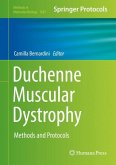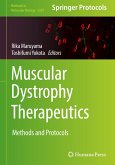The term "muscular dystrophy" (MD) describes a group of primary genetic disorders of muscle that often have a distinctive and recognizable clinical p- notype, accompanied by characteristic, but frequently not pathognomonic, pathological features. Research into the molecular basis of the MDs by a c- bination of positional cloning and candidate gene analysis has provided the basis for a reclassification of these disorders, with genetic and protein data augmenting traditional clinically based nomenclature. These findings have brought insights into the molecular pathogenesis of MD, with an increasing number of potential pathways involved in arriving at a dystrophic phenotype. Some common themes can be recognized, however, including the involvement of five members of the dystrophin-associated complex (dystrophin and four sarcoglycans) in different types of MD, and the involvement of two nuclear envelope proteins in producing an Emery-Dreifuss MD phenotype. Other d- ease-associated genes appear to cause MD in a completely unrelated way, such as the involvement of calpain 3 in a form of limb-girdle muscular dystrophy. Section 1 of Muscular Dystrophy: Methods and Protocols reviews tra- tional strategies used to identify MDs. Meantime, techniques developed as a result of the research strategies described previously have become an integral part of the management of many patients with MD and their families, and these techniques are addressed in Sections 2 (DNA-based tests) and 3 (p- tein-based analyses). The continued effort to translate this enhanced und- standing into a molecular cure or treatment for MD is reviewed in Section 4.
Hinweis: Dieser Artikel kann nur an eine deutsche Lieferadresse ausgeliefert werden.
Hinweis: Dieser Artikel kann nur an eine deutsche Lieferadresse ausgeliefert werden.
"This book will be of primary interest to pathologists, geneticists, and neurologists actively engaged in molecular testing of the patients with muscular dystrophy. . .This is a highly practical book aimed at scientists actively engaged in doing the molecular tests. Diseases covered include the X-linked muscular dystrophies and the autosomal recessive muscular dystrophies. Both DNA and protein methods are covered. Concluding chapters discuss gene therapy and animal models of muscular dystrophy."-Doody's Health Sciences Book Review Journal
"Several of the authors have been major players in making it all possible. It is remarkable to observe how many of the scientific discoveries have had immediate impact on molecular testing and thus have benefited many families through more accurate diagnoses and counseling....After a well-written background section, a major portion of the book deals with the molecular approach to X-linked DMD...Outstanding multiplex and Southern procedures are described in great detail, with primer sequences and maps of the restriction fragment patterns provided....Carrier testing, prenatal testing, and genetic counseling are also well covered in the remaining chapters dealing with DMD....The last major section of the book deals with protocols for testing the protein products of several of the dystrophies described earlier. This is an excellent addition because there are often times where the protein analysis is not only supportive but is the definitive test for an accurate diagnosis. Both immunocytochemical and Western immunoblotting are described. I have little doubt that this book will be of great interest and a reference text for laboratory directors specifically involved in muscular dystrophy testing. The techniques are described in great detail with excellent figures. This book will also be of interest to the clinical neurologists who often encounter these disorders. The editors have provided a comprehensive account of not only the methods, but also the clinical utilities of the methods." - Clinical Chemistry
"...this book certainly lives up to the back-cover hype ("comprehensive and highly practical"; "offers...an authoritative collection of tools"). I was particularly impressed by the emphasis on the limitations of each technique, directions for interpretation, important controls and the level of rigor required in a diagnostic setting. The chosen authors are almost without exception recognized as first-rate practitioners of their respective techniques. Their distilled wisdom, the microlitre-by-microlitre protocols, and the tried-and-tested primer sequences (well over 800) make this book an almost sufficient guide to the de novo establishment of a muscular dystrophy diagnostic lab." - Human Genetics
"Several of the authors have been major players in making it all possible. It is remarkable to observe how many of the scientific discoveries have had immediate impact on molecular testing and thus have benefited many families through more accurate diagnoses and counseling....After a well-written background section, a major portion of the book deals with the molecular approach to X-linked DMD...Outstanding multiplex and Southern procedures are described in great detail, with primer sequences and maps of the restriction fragment patterns provided....Carrier testing, prenatal testing, and genetic counseling are also well covered in the remaining chapters dealing with DMD....The last major section of the book deals with protocols for testing the protein products of several of the dystrophies described earlier. This is an excellent addition because there are often times where the protein analysis is not only supportive but is the definitive test for an accurate diagnosis. Both immunocytochemical and Western immunoblotting are described. I have little doubt that this book will be of great interest and a reference text for laboratory directors specifically involved in muscular dystrophy testing. The techniques are described in great detail with excellent figures. This book will also be of interest to the clinical neurologists who often encounter these disorders. The editors have provided a comprehensive account of not only the methods, but also the clinical utilities of the methods." - Clinical Chemistry
"...this book certainly lives up to the back-cover hype ("comprehensive and highly practical"; "offers...an authoritative collection of tools"). I was particularly impressed by the emphasis on the limitations of each technique, directions for interpretation, important controls and the level of rigor required in a diagnostic setting. The chosen authors are almost without exception recognized as first-rate practitioners of their respective techniques. Their distilled wisdom, the microlitre-by-microlitre protocols, and the tried-and-tested primer sequences (well over 800) make this book an almost sufficient guide to the de novo establishment of a muscular dystrophy diagnostic lab." - Human Genetics








